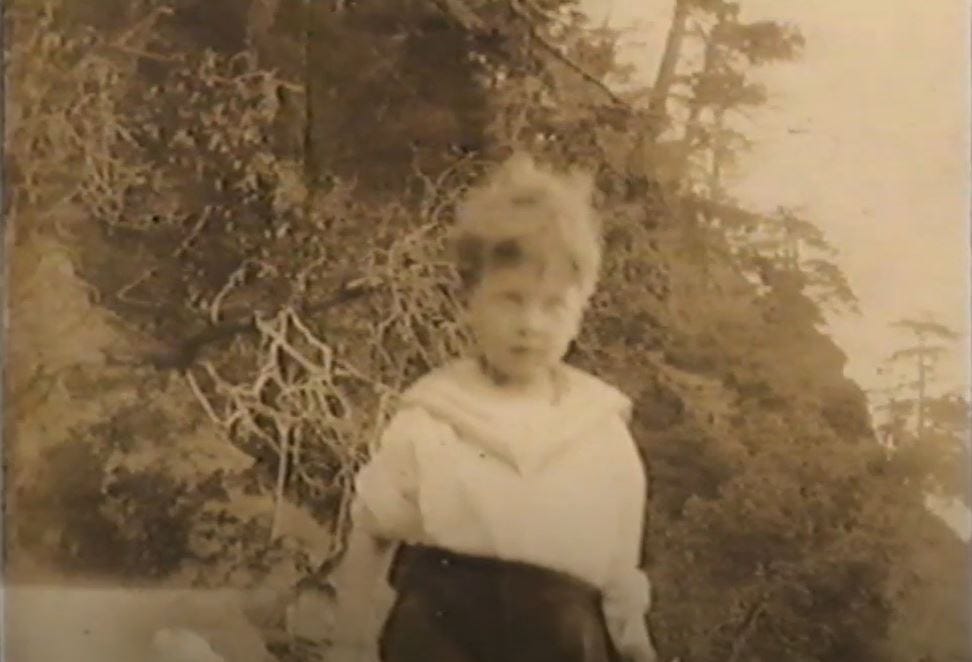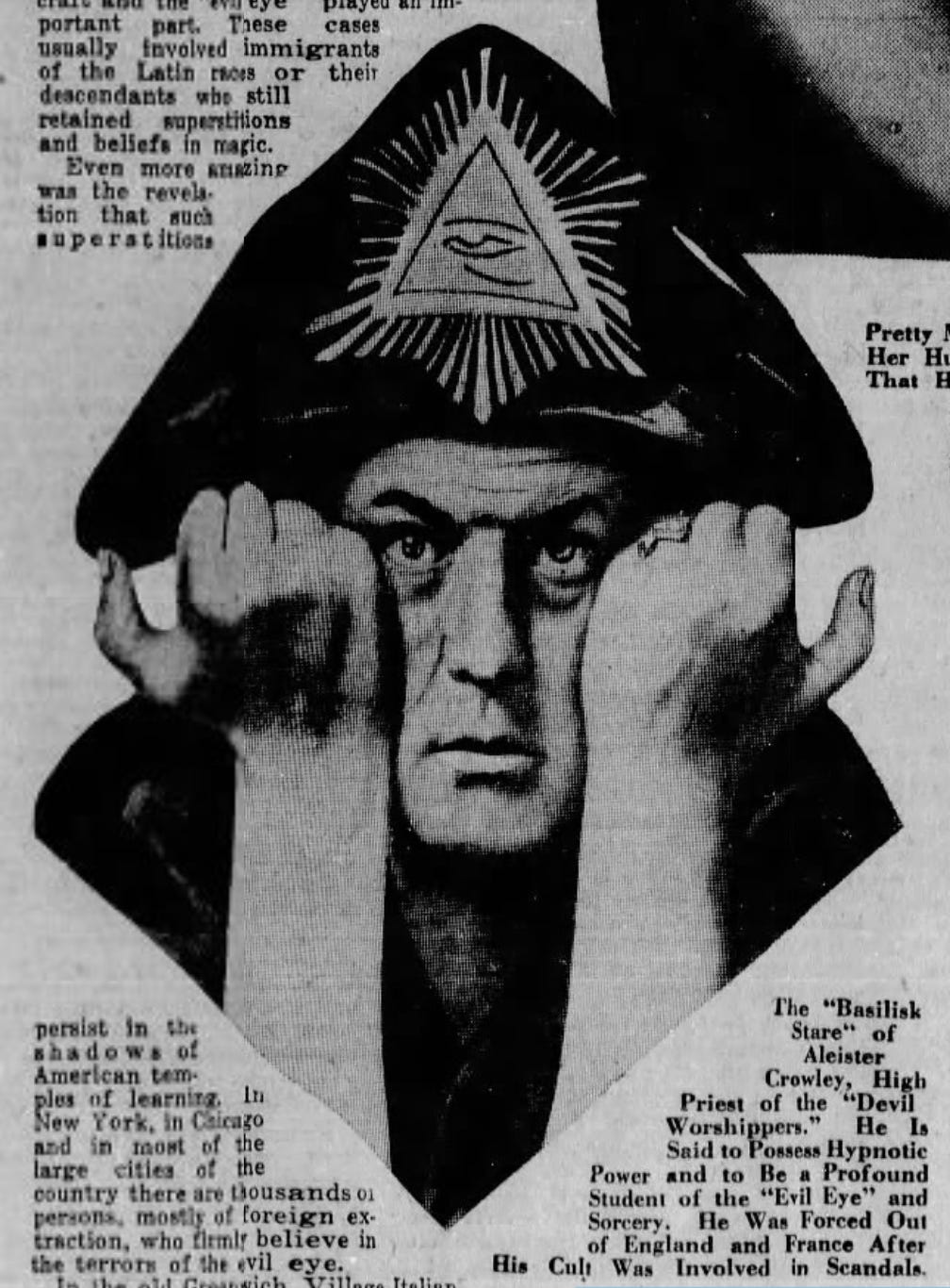Smiths "very eclectic in their religious activities"
Christianity and Theosophy at the Besant Lodge
It should be news to no one exploring this backwater of the www that Harry Everett Smith fluxed up the headlines of his life story. Facts and tall tales are never far from each other in the ravels of his early history, including in the spiritual history of Harry’s family in the Pacific Northwest.

Harry told stories about his occult family history that had already become part of folkie lore in the sixties, as shown in an interview with John Cohen (originally published in Sing Out! in 1969), which appears in the new edition of Harry Smith - American Magus:
JC: Someone once told me that you were thinking for a while that your father might have been some English Mystic who was traveling through.
HS: That was Aleister Crowley, and as a matter of fact, my mother did know Crowley at about that time. She saw him running naked down the beach. Perhaps in 1913 or 1915. I wish I had gone more into the chronology of my antecedents.
JC: But he’s not your father.
HS: I don’t know.
JC: Oh, you mean there’s a possibility?
HS: Sure. I suppose there’s a possibility that President Coolidge was.
Stranger than Harry’s humor is the fact that Crowley did visit the Pacific Northwest near this time, though no articles about Crowley surface to searches in available Washington State newspapers until the late 1920s, where he is featured in gossip column photos as “The Beast 666.”
Harry also said that his grandmother was “a friend of people like Annie Besant,” whose 1892 Seattle lecture “Death and After” was listed in the Anacortes American. In the 1920s, northwest Theosophists like Ray Wardall spoke throughout the region, including at the Besant Lodge in Seattle where his topic was “Theosophy and Christianity.”
In a conversation with Dawn Michelle Baude, included in Think of the Self Speaking, Harry recalled of the household library in his childhood, “I would say that the books lying around the house were basically Theosophical.” But when asked “So your parents were Theosophists?” Harry answered: “To a degree. They were very eclectic in their religious activities. For example, I went to a great number of different Sunday schools…”
Considering Theosophy and Christianity in the eclectic spiritual lives of the Smith family, I wondered what membership lists or church rolls they might be found on.
The Theosophical Society website features a quote from its founder, Helena Petrovna Blavatsky: "There is no higher religion than the truth." An archivist at the Society was kind enough to search for Harry’s family, writing “I could not find any reference whatever to this family in our records:
“It seems entirely possible that Robert James Smith and Mary Louise Hammond Smith were interested in Theosophy and conveyed that knowledge to their son, even if they were not members of our Society. Many Theosophists are independent of any organization, and study the many books that are available. Also, it is possible that the Smiths were involved with one of the many other branches of the broader Theosophical Movement. Theosophists, spiritualists, and other kindred non-mainstream groups were definitely meeting in Bellingham from the 1890s on, although I could not find much activity in Anacortes.”
Orcas Island was also an outpost for Theosophy, and the San Juan Islander editorialized on the subject in 1908. A Theosophist camp that was established on the island in 1927 exists to this day. Theosophists espoused beliefs like respect for the unity of all life and direct intuition of god through spiritual ecstasy. Open-minded inquiry as a religious value is a theosophical principle that Harry seemed to practice throughout his life. It is possible that the Smiths’ interest in Theosophy, attributed to them by Harry, may have taken hold on Orcas.
Theosophical and occult interests didn’t often enter into small town society news. What can be learned of Harry Smith’s parents during their years in Anacortes (1932-1942) is the many times Robert and Mary’s connection to their local Episcopal congregations did make the pages of the Anacortes American and the Anacortes Daily Mercury.
The archives at the Episcopal church in Anacortes contain more on the Smith family's involvement there. In meeting minutes, the business of maintaining Christ Episcopal Church during the Great Depression is detailed. Robert served on the Bishop’s Committee for years, attending to repairs of roof leaks and broken pipes: “The matter of getting fuel for the church was discussed and Mr. Smith was directed to get coal in sacks for that purpose.”
Meanwhile, Mary Louise Smith was president of the Christ Church Episcopal Guild from 1934-1937, focusing on church decoration and fundraising. Dues were 10 cents a month or $1 for the year if paid in advance. Projects included food, plant and craft sales: “Mrs. Venables reported that Mrs. McNary (Publisher of the Anacortes Daily Mercury) would like 24 canvas bags made for the news paper boys. After some discussion it was voted on and passed that we make the bags.”
Most meetings of the guild were hosted in the homes of members. Interesting that on Mary’s turn the minutes for September 24, 1936 note: “Guild was entertained by Mrs. Smith at Amsberry’s tea room.” While we are down this rabbit hole, we might wonder if this outing was a way of avoiding public scrutiny of the two-house living arrangement that the Smiths maintained at the Apex cannery? Or was it seen as a display that the Smiths were connected to money and could afford to entertain at a restaurant during tough economic times?
If the Smiths were involved in church work as a front for their occult activities, history shows they played their small-town WASP roles very convincingly.
American Magus, in title and content, explores the mysticism of Harry Smith. Harry’s spiritual upbringing (and his actual parents) were subjects he discussed with Lionel Ziprin, whose family Harry worked for and lived amidst for years. Ziprin said that Harry’s interest in Crowley began after they met, when Harry was nearly thirty:
“There’s a book about Aleister Crowley … and on the cover is a painting by Crowley of a spirit called Kwaw; it was not a good painting, but anyway it looked exactly like Harry Smith with a red beard. So from then on he started to have an obsession about this man and he took off on that subject for years. I mean I had no interest in him. I thought he was sort of a comedian, a sort of comic Barnum and Bailey, a sort of W.C. Fields of magic.”
William Breeze noted that Harry’s family was “active in freemasonry and occultism” and that “he enjoyed propagating alternative biographies.” Yet in an interview, Harry Smith almost interrupted John Cohen’s question about his family involvement in “the occult and magick” to say: “I’m not so interested in that anymore.”
Elsewhere Harry said: “When I was a child, there were a great number of books on occultism and alchemy always in the basement. Like I say, my father gave me a blacksmith shop when I was maybe twelve. He told me I should convert lead into gold.”
The mundane and mystical ebb and flow through Mary and Robert Smith’s “eclectic religious activities,” and Harry was carried along. On May 17, 1936, nearing his thirteenth birthday, Harry was baptized at Christ Episcopal Church in Anacortes. His sponsors were Elmer Dabney (principal at Anacortes High School), Luella Howard (Head Librarian at the Anacortes Public Library), Geoffrey and Frances Venables (son and wife of Christ Episcopal’s pastor). Harry’s involvements in other church activities - if there were any beyond his near-teen baptism - are unknown.



